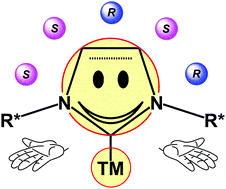BOC Sciences has developed various types of efficient and highly coordination ability chiral ligands for asymmetric reaction, and further utilizes these ligands to complete the synthesis of chiral compounds. Our chemical engineering and process research departments have dedicated organometallic chemists with extensive screening expertise. In addition, we are equipped with specialized equipment capable of efficiently producing large quantities of chiral auxiliaries and catalysts.
Introduction
Asymmetric metal catalysis has been regarded as one of the most powerful tools for the preparation of stereochemically pure chiral organic molecules. A chiral metal catalyst generally comprises a central metal atom and a chiral ligand, and its reactivity and selectivity are heavily dependent on the ligand attributes. The ligand is an enantiopure organic compound that binds to the metal center via chelation to form an asymmetric catalyst. Conventional chiral ligands rely on a covalently constructed, single chiral molecule embedded with coordinative functional groups. Their syntheses from each single molecule with the requisite chirality often require multi-step operation and can be complicated. Thus, an alternative strategy that allows the simple and rapid preparation of structurally diverse chiral ligands would be of significant importance.
 Chem. Soc. Rev. 2017,46: 4845-4854.
Chem. Soc. Rev. 2017,46: 4845-4854.
Chiral ligands can be classified into several groups according to their molecular skeleton, that is chiral biphenyl ligands (axial chirality), metallocene-based chiral ligands (planar chirality), chiral spiro ligands (axial chirality) and chiral ligands with only central chirality. Among them, chiral ligands with biphenyl and binaphthyl backones are the most widely studied and used ligands in asymmetric catalysis. This is because these skeletons are highly rigid and can be easily modified at the 3,3'-positions, which are close to the reaction center. The metallocene is the most popular backbone for metallocene-based chiral ligands, especially ferrocene, which is commercially available and inexpensive. Therefore, metallocene-based chiral ligands have attracted much attention from organic chemists. Moreover, chiral ligands bearing central chirality were prepared at the earliest stages of the development of chiral ligands because of its wide applicability, high cost performance, easy preparation and environmental friendliness.
Application
Chiral compounds are active ingredients in many small-molecule drugs, so the controllable synthesis of chiral molecules has become a key step in drug development. Organic chemists have developed a series of versatile and well-known chiral ligands that have shown extremely good activity in asymmetric organocatalysis reactions. For example, ligands bearing chiral phosphine and sulfur groups have shown good performance in asymmetric hydrogenations, dipolar cycloadditions, cross-couplings, arylboron additions and borylations of double bonds. Furthermore, chiral nitrogen ligands also have exhibited excellent catalytic performance in various asymmetric reactions, such as C-C bond forming reactions, carbonyl-ene reactions, hydrosilylation, cycloaddition, hydrogenation, ect. The rational use of chiral ligands to construct asymmetric organic catalysts can efficiently and selectively synthesize a series of pharmaceutical intermediates, which are widely used in pharmaceutical production.
References:
- Ooi, T. et al. Design of supramolecular chiral ligands for asymmetric metal catalysis. Tetrahedron Letters. 2015, 56: 2043-2048.
- Zhang, J. et al. Chiral ligands designed in China. National Science Review. 2017, 4: 326-358.
Chiral Technical Information

 Chem. Soc. Rev. 2017,46: 4845-4854.
Chem. Soc. Rev. 2017,46: 4845-4854.










